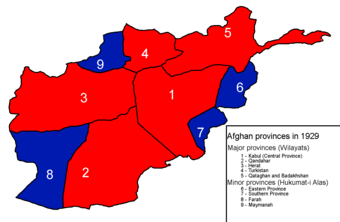Emirate of Afghanistan (1929)
The Emirate of Afghanistan was an unrecognized state ruled by the Saqqawists that existed from January to October 1929. Habibullāh Kalakāni became the state's only emir on 18 January 1929.[2] After the fall of Kalakani on 13 October 1929, the Emirate ended.
Emirate of Afghanistan | |||||||||
|---|---|---|---|---|---|---|---|---|---|
| 1929–1929 | |||||||||
.svg.png) Flag
.svg.png) Coat of arms
| |||||||||
.png)
| |||||||||
| Status | Emirate | ||||||||
| Capital | Kabul | ||||||||
| Religion | Islam (official)[1] | ||||||||
| Government | Monarchy | ||||||||
• 1929 | Habibullāh Kalakāni | ||||||||
| History | |||||||||
• Established | 18 January 1929 | ||||||||
| 13 October 1929 | |||||||||
| Currency | Afghan rupee | ||||||||
| |||||||||
| Today part of | Afghanistan | ||||||||
History
Administrative Divisions

Government
Once in power, the Saqqawists abolished conscription and taxation, and closed down schools.[3]
Economy
For a while, Kalakani relied on the royal treasury to pay his army, without levying taxes. However, when the treasury ran out, taxation was reinstated. Taxation was collected by grabbing people's wealth in order to cover the expenses of his army. Revenue was also collected by forcing wealthy Tajik merchants to contribute to his treasury.[3]
Military
The Saqqawists maintained a military during their period of control. On 14 April 1929, Fayz Muhammad estimated the Saqqawists to number 20,000.[4]
Culture
The Saqqawist government celebrated Afghan Independence Day for 5 days (instead of the usual 8) starting on 19 August 1929. Kalakani spent 60,000 Afghan rupees on the celebrations, and hoped he could use the occasion to try and win over the Afghan populace. Kalakani held a speech on 19 August – the contents of the speech are unknown, but Fayz Muhammed remarked that Kalakani "stood there telling lie after lie about the way things really were."[5]
International relations
Despite taking control of Kabul, The Saqqawist government of Afghanistan was unable to obtain any diplomatic recognition.[6] Nonetheless, the Saqqawists allied themselves with the Basmachi movement, allowing them to operate in Northern Afghanistan. and revoking the "Pact of Neutrality and Non-Aggression" that Afghanistan had signed with the Soviet Union following the end of the Urtatagai conflict, which obligated Afghanistan to restrain Basmachi border raids.[7]
References
- Ali, Mohammed (1933). Progressive Afghanistan. Punjab Educational Electric Press. pp. 29.
- Muḥammad, Fayz̤; Hazārah, Fayz̤ Muḥammad Kātib (1999). Kabul Under Siege: Fayz Muhammad's Account of the 1929 Uprising. Markus Wiener Publishers. p. 1. ISBN 9781558761551.
- Miraki, Mohammed (2000). "Chapter 6: The Anarchy of Habibullah (Bacha-e-Saqao) from January 1929 to October 1929". Factors of underdevelopment in Afghanistan, 1919-2000.
- Muḥammad, Fayz̤; Hazārah, Fayz̤ Muḥammad Kātib (1999). Kabul Under Siege: Fayz Muhammad's Account of the 1929 Uprising. Markus Wiener Publishers. p. 163. ISBN 9781558761551.
- Muḥammad, Fayz̤; Hazārah, Fayz̤ Muḥammad Kātib (1999). Kabul Under Siege: Fayz Muhammad's Account of the 1929 Uprising. Markus Wiener Publishers. pp. 238, 239, 240, 241. ISBN 9781558761551.
- Muḥammad, Fayz̤; McChesney, R. D. (1999). Kabul under siege: Fayz Muhammad's account of the 1929 Uprising. Markus Wiener Publishers. p. 236. ISBN 9781558761544.
- Ritter, William S. (1990). "Revolt in the Mountains: Fuzail Maksum and the Occupation of Garm, Spring 1929". Journal of Contemporary History. 25 (4): 547–580. doi:10.1177/002200949002500408. ISSN 0022-0094. JSTOR 260761.